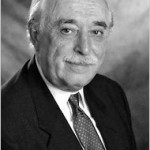This post is a bit of a departure from anything I’ve written previously. On Sunday, Alan Haberman, the man who was responsible for introducing the bar code, or universal product code — U.P.C., to the United States in 1973, passed away at the age of 81 in Massachusetts. You might be wondering why I chose to bother writing about this man and how it relates to marketing. The bar code is the “first generation” of what marketers are beginning to use more recently, two-dimensional, cellphone-scannable bar codes, and more specifically QR codes. Our blog often talks about the latest technology, but in this post I’m going to revisit the history of the bar code, so we know where some of our newer technology began (oh, and in case you didn’t know, I was a history major in college so I like this stuff).
The First UPCs
The first patent for the bar code was issued to inventors Joseph Woodland and Bernard Silver on October 7, 1952. Silver and Woodland were graduate students at Drexel Institute of Technology in Philadelphia and were asked by a local food chain owner to research a method of automatically reading product information during checkout. Unfortunately, scanning equipment was very poor at this time so the bar code process went virtually unused.
Over the next two decades, some retailers and manufacturers tried to develop their own systems, but each one was different and unintelligible to the other, so nothing took hold.
Industry Collaboration
It wasn’t until the early 1970s, when inflation began rising and supermarket chains were looking for a way to cut labor costs by automating how their stock was calculated, inventoried and rung up that a concerted effort was made to develop a single system. Alan Haberman led the industry committee that chose the bar code over other symbols in April 1973 (George J. Laurer of I.B.M. invented and holds the patent for the U.P.C.). Haberman recalled, “We showed that it could be done on a massive scale, that cooperation without antitrust implications was possible for the common good, and that business didn’t need the government to shove them in the right direction.”
Guidelines
Haberman and his committee established some guidelines for those submitting bar codes for consideration. The bar codes had to be readable from almost any angle and at a wide range of distances. They would have to make life easier for the cashier, not more difficult, and the labels would have to be cheap and easy to print since they would be reproduced for millions of products. To remain affordable, the new checkout scanners would have to pay for themselves in 2-½ years. “It turns out there were massive savings that we called hard savings, out-of-pocket savings in labor and other areas,” Haberman said.

Persuasion
According to all historical documentation, Haberman spent the next several years persuading manufacturers, retailers and the public to accept the strange new bar code symbol. His efforts brought together the basic concept of commerce with the newest technology, much as we see happening now with QR codes.
Standards Council
Haberman became the founder and long-serving board member of the Uniform Code Council, and was for decades a proponent for automated product identification in all forms (from the bar code to newer technologies like radio frequency identification).
In summary, it can be easy to overlook the obituary of a man whose name doesn’t hold celebrity status. However, when reading the impact his work has had on our everyday lives and the effect on future technology, we’re reminded to take a moment to pause and not always look forward to the next piece of new technology but think about where all this new technology comes from. There were technology pioneers before Steve Jobs and Bill Gates. Their names are not as famous but their impact has been great.
On June 26, 1974, in a Marsh supermarket in Troy, Ohio a man purchased a single pack of Wrigley’s Juicy Fruit Chewing Gum. It was the first purchase made using the new bar code system. That pack is now in the Smithsonian as part of its permanent collection.
Related articles





